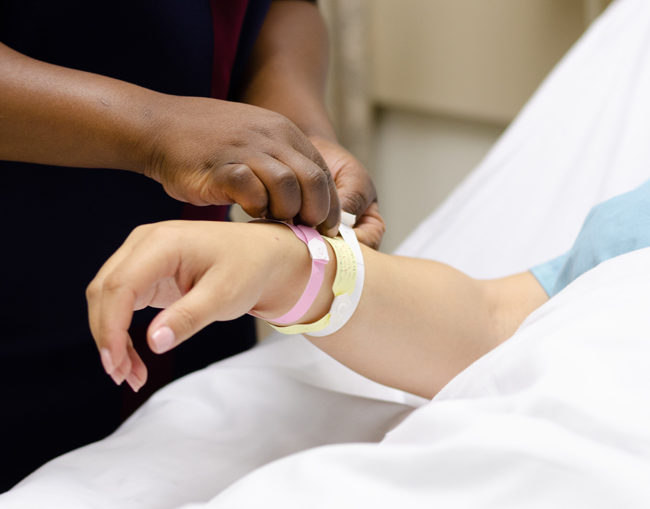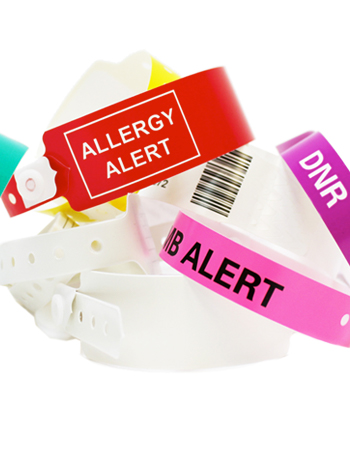How Patient Identification Band Enhances the Overall Patient Experience in Medical Facilities
How Patient Identification Band Enhances the Overall Patient Experience in Medical Facilities
Blog Article
Person Recognition Bands: A Trick Tool for Improved Medical Precision
Client identification bands stand for an essential part in the quest of clinical accuracy and patient security within medical care environments. The true extent of their impact on person outcomes and overall medical care high quality warrants additionally evaluation.

Relevance of Client Identification
Patient recognition is an essential component of health care that makes sure the safety and accuracy of medical therapy. Appropriate identification methods are necessary to prevent clinical mistakes, which can lead to unfavorable person results, consisting of incorrect medication administration, misdiagnosis, or inappropriate therapy strategies. The value of accurate client identification can not be overemphasized, as it functions as the structure for efficient interaction amongst doctor.
In environments where numerous clients are obtaining treatment concurrently, the risk of identification confusion boosts. Carrying out durable recognition systems aids mitigate these risks and enhances client security. Patient Identification Band. Exact identification adds to the stability of medical documents, making sure that person backgrounds, allergies, and previous treatments are appropriately connected to the appropriate person.
Moreover, compliance with regulatory standards and certification needs typically mandates strict client identification procedures, promoting a culture of responsibility and quality care. Ultimately, the significance of client recognition goes beyond plain administrative jobs; it is a basic element of providing high-quality health care that prioritizes individual safety and improves scientific results. Spending in efficient identification techniques is not just beneficial-- it's crucial in today's facility health care landscape.
Sorts Of Individual Identification Bands
In medical care setups, various sorts of client recognition bands are utilized to make sure exact identification and enhance security. These bands work as an essential tool in preventing medical errors associated with client misidentification.
The most usual kind is the conventional wristband, usually made of resilient plastic and published with the individual's name, date of birth, and a special recognition number. These wristbands are often color-coded to communicate certain information, such as allergic reactions or other medical conditions.
One more kind is the barcode wristband, which includes a scannable barcode connected to the client's electronic health document. This technology enables effective data access and confirmation throughout drug administration and various other professional procedures.
Additionally, RFID (Radio Frequency Identification) bands are ending up being progressively preferred. These bands can communicate wirelessly with medical facility systems, permitting real-time tracking and identification of patients, therefore enhancing workflows and improving patient safety and security.

Benefits for Medical Care Companies
Using individual recognition bands uses considerable advantages for healthcare companies, enhancing both functional effectiveness and patient security. These bands serve as an important tool in enhancing individual management procedures (Patient Identification Band). By making sure accurate identification, medical care companies can decrease the risk of management errors, such as mislabeling samples or misdirecting therapies, which can cause pricey hold-ups and issues
Furthermore, patient recognition bands promote smooth communication among the healthcare group. With conveniently obtainable and standardized person details, providers can make educated decisions promptly, boosting general workflow. This performance is specifically crucial in high-pressure settings such as emergency departments, where time-sensitive interventions are essential.
The application of recognition bands additionally sustains conformity with regulative criteria and finest techniques, consequently reducing the risk of legal effects stemming from recognition errors. The usage of these bands boosts data precision in electronic health documents, leading to far better treatment sychronisation and continuity.
Influence On Patient Security
Precise client identification is a cornerstone of healthcare security, considerably lowering the probability of mistakes that can jeopardize client health. Making use of patient recognition bands is important in ensuring that each patient obtains the proper treatment, medicines, and treatments. These bands function as a reliable reference website here point for health care professionals, lessening the threat of misidentification, which can cause significant effects such as incorrect medication management or medical mistakes.
The execution of standardized client identification bands adds to a culture of safety and security within health care settings. By providing clear, quickly understandable details, these bands aid to enhance the significance of confirming person identity at every phase of treatment. They promote communication amongst team members, making sure that every person included in a patient's treatment is conscious of their specific requirements and demands.
On top of that, making use of individual recognition bands can boost the accuracy of electronic health records, additionally reducing the possibility for mistakes - Patient Identification Band. By prioritizing individual safety and security via efficient identification methods, healthcare suppliers can cultivate count on and self-confidence among individuals, ultimately resulting in better professional end results and boosted individual satisfaction. The effect of correct patient recognition can not be overstated; it is a fundamental component of top notch medical care distribution
Ideal Practices for Application
Reliable implementation of client recognition bands is vital for boosting patient safety and decreasing errors in healthcare setups. Personnel training is essential; all group members should understand the significance of accurate patient recognition and the procedures for band application.
2nd, the style of the identification bands ought to prioritize presence and toughness. Bands need to be very easy to review, consist of vital person info, and stand up to daily wear. Making use of color-coding can further enhance quick identification.


Third, integrating electronic health records (EHR) with identification band systems can enhance workflow. Automated signals for discrepancies in client identification check over here can protect against potential mistakes before they take place.
Last but not least, performing normal audits and responses sessions will aid determine locations for renovation. Engaging staff in these conversations promotes a culture of safety and security and responsibility.
Final Thought
In conclusion, individual identification bands play an essential role in improving medical precision and making certain client security within health care systems. Embracing best practices for execution cultivates a culture of security, eventually leading to enhanced client results and higher trust fund in healthcare solutions.
Client recognition bands stand for an important part in the pursuit of clinical precision and person safety within healthcare atmospheres.Utilizing over at this website person recognition bands offers significant advantages for healthcare carriers, boosting both functional effectiveness and person safety and security. By prioritizing client safety with reliable identification practices, health care suppliers can cultivate trust fund and confidence among people, inevitably leading to better medical outcomes and improved client contentment.Reliable execution of person identification bands is important for boosting patient safety and minimizing errors in healthcare settings.In final thought, individual recognition bands play an essential duty in boosting clinical accuracy and making certain individual safety within medical care systems.
Report this page